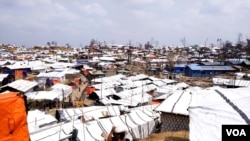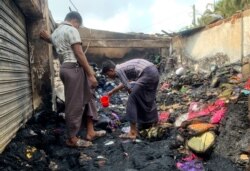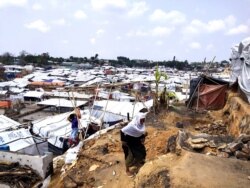Rohingya refugees in Bangladesh are living in renewed fear after deadly fires broke out more than 30 times in the southeastern Cox’s Bazar district in recent weeks.
Rights activists said these fires are part of a “very worrying trend” in the overcrowded, sprawling shantytown that is home to dozens of interconnected makeshift refugee settlements.
“Every day and night Rohingyas across the camp are living in fear that fire will break out again somewhere in the camp,” a Cox’s Bazar-based Rohingya rights activist who goes by Hussain told VOA. Many Rohingya use only one name.
“Fires are breaking out time and again,” he said, “at least 32 times in different parts of the Rohingya camp in Cox’s Bazar in the past 17 days, after the devastating March 22 fire.”
The rights activist said the perpetrators in recent fires were caught and turned over to authorities.
“We caught seven or eight people red-handed while they were setting ablaze some shacks,” he said. “They were all handed over to police.”
About 1 million Rohingya Muslim refugees have been living in the bamboo and tarpaulin shanties in the congested Cox’s Bazar district since fleeing military clampdowns in neighboring Myanmar in recent years, according to the United Nations. There are 34 encampments within in the district where Rohingya refugees have settled, which are collectively identified as one expansive settlement, including the Balukhali and nearby Kutupalong refugee camps, according to the International Organization for Migration.
On March 22, a fire ripped through the Balukhali area of the camp, killing at least 15 refugees, authorities said. Sanjeev Kafley, the International Federation of Red Cross and Red Crescent Societies delegation head in Bangladesh, told Reuters that more than 17,000 shelters were destroyed, and thousands of people were displaced in the area because of the fire. The Office of the United Nations High Commissioner for Refugees estimated that the fire injured around 550 refugees and left more than 48,000 homeless.
Last week, a statement from the UNHCR in Bangladesh said, “Multiple small fires have been reported across camps in Kutupalong and Nayapara [of Cox’s Bazar] in [the] last week. This is a very worrying trend. Refugees have managed to put out the fires quickly with only a limited number of families affected.”
While several thousand victims of the March 22 fire remain without shelter, more incidents of fire have been reported, leading refugees to live in constant fear. On April 2, at least three people were killed and more than 20 shops were gutted in a makeshift market near Kutupalong refugee camp, according to police and witnesses.
Several Rohingya community leaders in Cox’s Bazar said many refugees fear fire could break out again.
Mohammad Harris, 32, living in Balukhali, told VOA that refugees live in constant fear.
“We are very scared. We are passing sleepless nights. That devastating fire on March 22 destroyed my home completely,” Harris said.
“Somehow, I have built a shack with bamboo and polythene again, taking lots of trouble,” he said. “With my wife and children, five of us are living here, but the way incidents of fire are taking place at one place or other in the camp every day, I fear, this house will get burnt to ashes, too.”
Abdus Shukur, 45, another refugee, from Kutupalong, said he believes the fires were caused by arson.
“Some people are secretly sprinkling a white inflammable powder on the roofs of our shacks. Some others are setting them on fire,” Shukur told VOA. “It is clear, they are not accidents. Some people are setting fire to the shacks as part of a conspiracy.”
The suspected perpetrators, he said, may be conspiring to scare Rohingya refugees from Cox’s Bazar by repeatedly setting fire to their makeshift homes.
"They want more Rohingya to move to Bhasan Char,” he said, referring to a remote Bay of Bengal island, “or they want all Rohingya to go back to Myanmar.”
Bangladesh has set up a facility on Bhasan Char, where it wants to relocate at least 100,000 Rohingya refugees from camps in Cox’s Bazar. A few thousand Rohingya have moved to the island in recent months but most are unwilling to relocate there, saying that the island is prone to flooding during high tide and largely disconnected from the mainland.
A day after the March 22 fire, Bangladesh said it would investigate the cause of the blaze, but authorities so far have not said what triggered the devastating fire.
Several senior government officials did not respond to questions from VOA asking about the cause of the fires. However, one midlevel police officer said that the cause is rivalry among feuding Rohingya criminal gangs.
“There is rivalry among different Rohingya anti-social groups,” the officer told VOA on the condition of anonymity because he is not authorized to speak to the media. “Members of one group are setting fire to the shanties belonging to its rival groups or their supporters.”
However, many Rohingya refugees living in the Cox’s Bazar disagree.
“At least three of those who were caught red-handed were [non-Rohingya] Bangladeshis,” said a Cox’s Bazar-based Rohingya refugee who withheld his name for fear of reprisal by police and locals. “We strongly believe the masterminds behind the fires are those who view the Rohingya as their enemy in Bangladesh and want them to flee the camps of Cox's Bazar.
“Those masterminds are using some hired anti-socials, who are Bangladeshis as well as Rohingyas, to carry out the fire attacks on us,” he added. “The fires cannot be rooted to any Rohingya conspiracy, we believe.”











